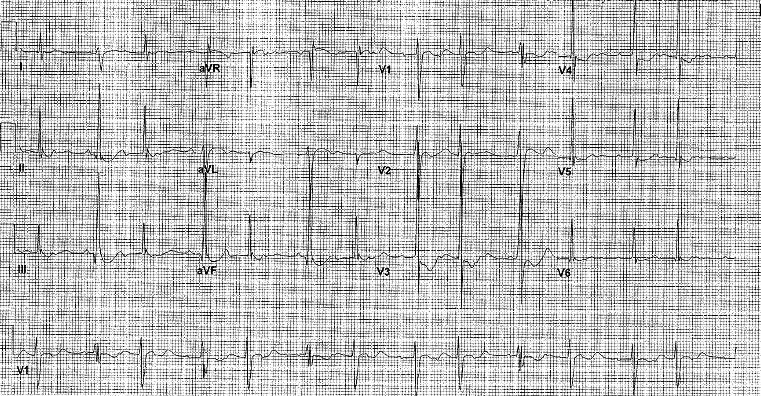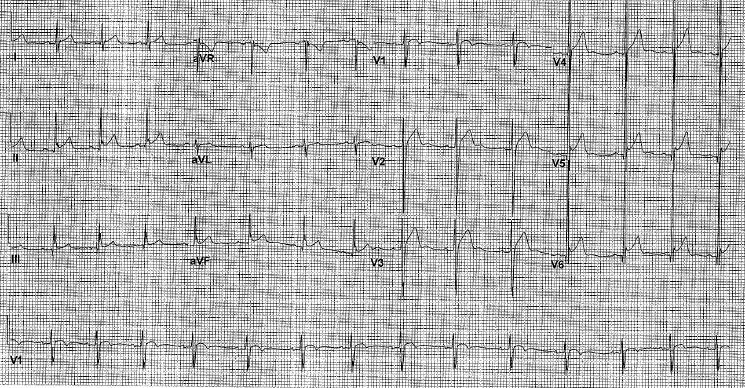- Clinical Technology
- Adult Immunization
- Hepatology
- Pediatric Immunization
- Screening
- Psychiatry
- Allergy
- Women's Health
- Cardiology
- Pediatrics
- Dermatology
- Endocrinology
- Pain Management
- Gastroenterology
- Infectious Disease
- Obesity Medicine
- Rheumatology
- Nephrology
- Neurology
- Pulmonology
Thyrotoxic Periodic Paralysis
Attacks of muscle weakness associated with this condition can range in severity from mild deficit to complete paralysis. Episodes may alternate with periods of normal muscle function.
Figure 1. Presenting ECG (click to enlarge).

Figure 2. ECG after potassium replacement.

A 23-year-old Asian man is carried into the emergency department (ED) by his brother. He is weak, unable to stand or move his legs. He reports that he woke earlier after a nap and was unable to get out of bed. He denies any past medical problems or recent trauma but admits to having recently experienced heat intolerance, occasional palpations, and diarrhea. He denies drug use and reports consuming 2 cans of beer two days ago. He denies recent weight loss or gain. He recalls a similar episode a few months ago but did not seek medical attention because the symptoms resolved.
Results of the physical examination were heart rate, 140 beats/min; blood pressure, 118/81 mm Hg; temperature 36.9°C (98.5°F); respiration, 24 breaths/min; oxygen saturation, 95%. He appears lethargic lying in bed. No thyroid enlargement, tenderness, mass, or bruit. Breath sounds are clear. He was unable to move his lower extremities off of the bed. He was able to move his upper extremities but was visibly weak. Lower extremity strength, 1/5; upper extremity strength, 3/5. He was able to maintain his airway and speak without difficulty. The remainder of his physical examination was normal.
ECG showed normal sinus rhythm with first-degree A-V block at 81 beats/min. U waves were present, consistent with hypokalemia (Figure 1). A complete metabolic panel revealed potassium, <1.5 mEq/L; anion gap <1.5 mEq/L; glucose, 214 mg/dL; calcium, 11.0 mg/dL; ionized calcium, 5.9 mg/dL; alkaline phosphatase, 170 IU/L; TSH, 0.01 µIU/mL; free T3, 16.3 pg/mL; free T4, 4.7 ng/dL; CPK, 24 IU/L; CK-MB, 7.0 ng/mL; and relative index, 3.1%.
Chest x-ray film was negative for retrosternal goiter. A thyroid uptake scan demonstrated an abnormal radioiodine uptake suggestive of Graves disease. No hot or cold nodules were identified.
The patient received 50 mEq of oral potassium in the ED and IV fluid hydration with potassium supplementation was initiated. He was admitted to the cardiac telemetry unit. Inpatient care included frequent positioning to prevent skin breakdown associated with immobility and physical and occupational therapy to restore strength and function. He was given dalteparin sodium 5000 units subcutaneously daily for thrombosis prophylaxis. Endocrinology was consulted for management of Graves disease. After potassium replacement, U waves are resolved and T waves are normalized (Figure 2).
Medications included methimazole 10 mg 3 times daily, potassium 20 mEq twice daily, and metoprolol tartrate 25 mg daily given in divided doses. On discharge, he was to follow up with endocrinology in 3 to 4 weeks. Unfortunately, the patient failed to keep the appointment and was lost to follow-up.
Discussion
Thyrotoxic periodic paralysis (TPP) is a condition characterized by episodes of muscle weakness in individuals with high thyroid hormone levels. It is most prevalent among males of Asian descent.1 The condition is always linked to hyperthyroidism and thought to be an autosomal dominant disorder. A precipitating factor triggers excess insulin production with a subsequent dramatic shift of potassium from the extracellular to the intracellular compartment.2 The result is a state of profound hypokalemia which, in turn, causes muscle weakness and periodic paralysis.2 The ECG tracing may show T-wave flattening, a U wave preceding the T wave in the same polar direction, as well as conduction abnormalities.3 A life-threatening dysrhythmia is highly probable in the absence of immediate intervention.
Symptoms associated with TPP include attacks of muscle weakness that can range in severity from mild deficit to complete paralysis; these may alternate with periods of normal muscle function. Episodes may be recurrent and can last from hours to several days; they are more common in the legs than the arms. Common triggers for attacks of TPP include meals rich in carbohydrates or with high salt content, sugar-laden snacks, alcohol, and coming to rest after strenuous exercise.1 Symptoms seen only rarely include difficulty with breathing, swallowing, and speech and changes in vision.1 In the case of our patient, the 2 cans of beer consumed before presentation may have been the trigger.
Alternative diagnoses to consider in the differential include hyperthyroidism, hypokalemia, hypophosphatemia, and drug abuse with accidental diuretic use.
Management consists of immediate IV supplementation of potassium chloride 40 to 200 mmol, and oral or IV beta-adrenergic blockers to block the effects of catecholamine response. Adequate IV hydration to perfuse the kidneys is essential, since rhabdomyolysis is highly probable and can lead to acute renal failure.2
Disclosures:
- MedlinePlus. U.S. National Library of Medicine NIH National Institutes of Health. Thyrotoxic periodic paralysis. http://www.nlm.nih.gov/medlineplus/ency/article/000319.htm. Accessed January 13, 2014.
- Kung A. Thyrotoxic periodic paralysis. A diagnostic challenge. J Clin EndocrinolMetab. 2006;91:2490-2495. http://press.endocrine.org/doi/pdf/10.1210/jc.2006-0356. Accessed February 27, 2014.
- Lopez S, Hendreson S. Electrocardiogram changes in thyrotoxic periodic paralysis. West J Emerg Med. 2012;13:512-513. http://www.ncbi.nlm.nih.gov/pmc/articles/PMC3555582/http://www.escholarship.org/uc/item/4d16p1q9. Accessed February 19, 2014.
